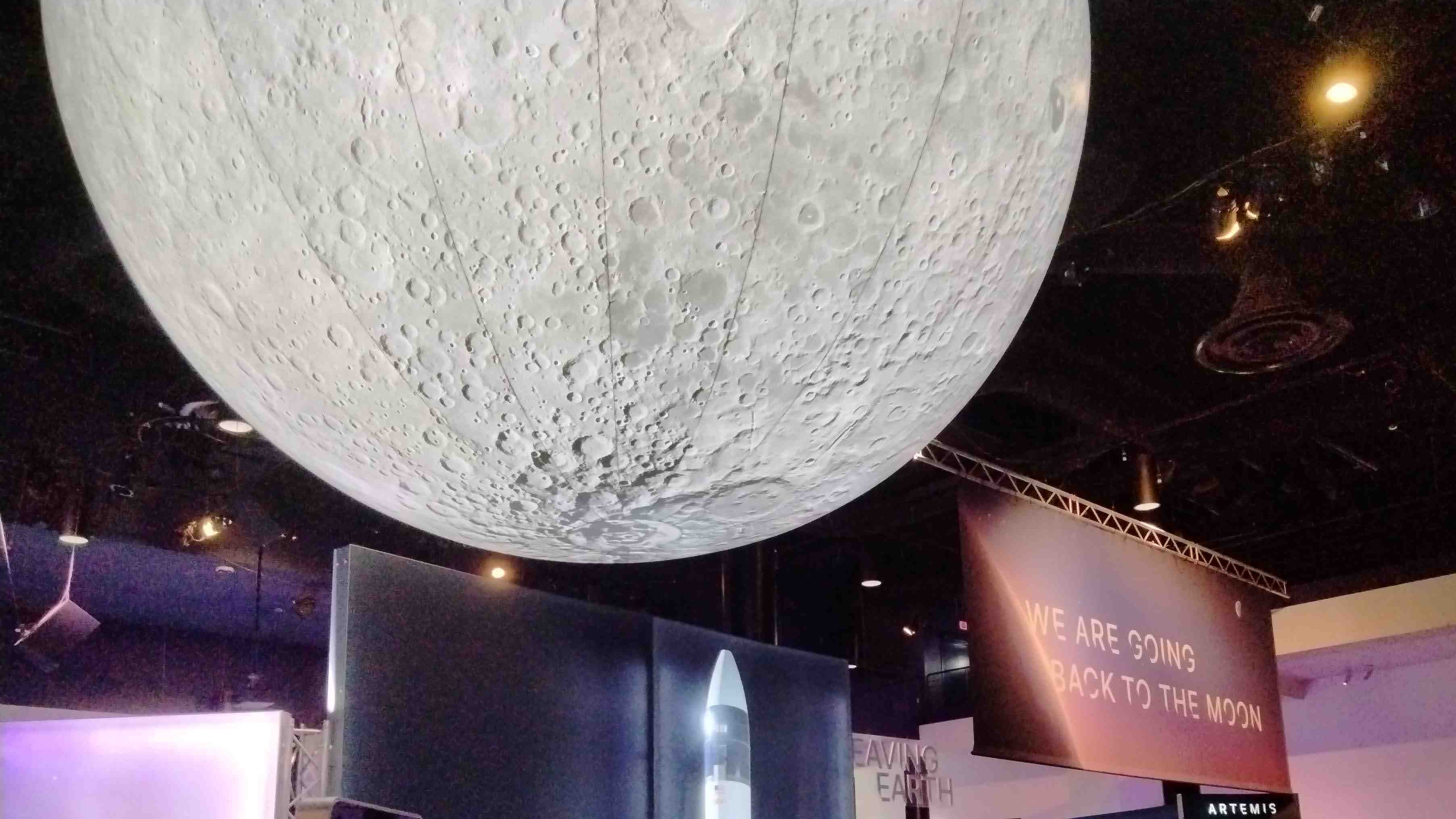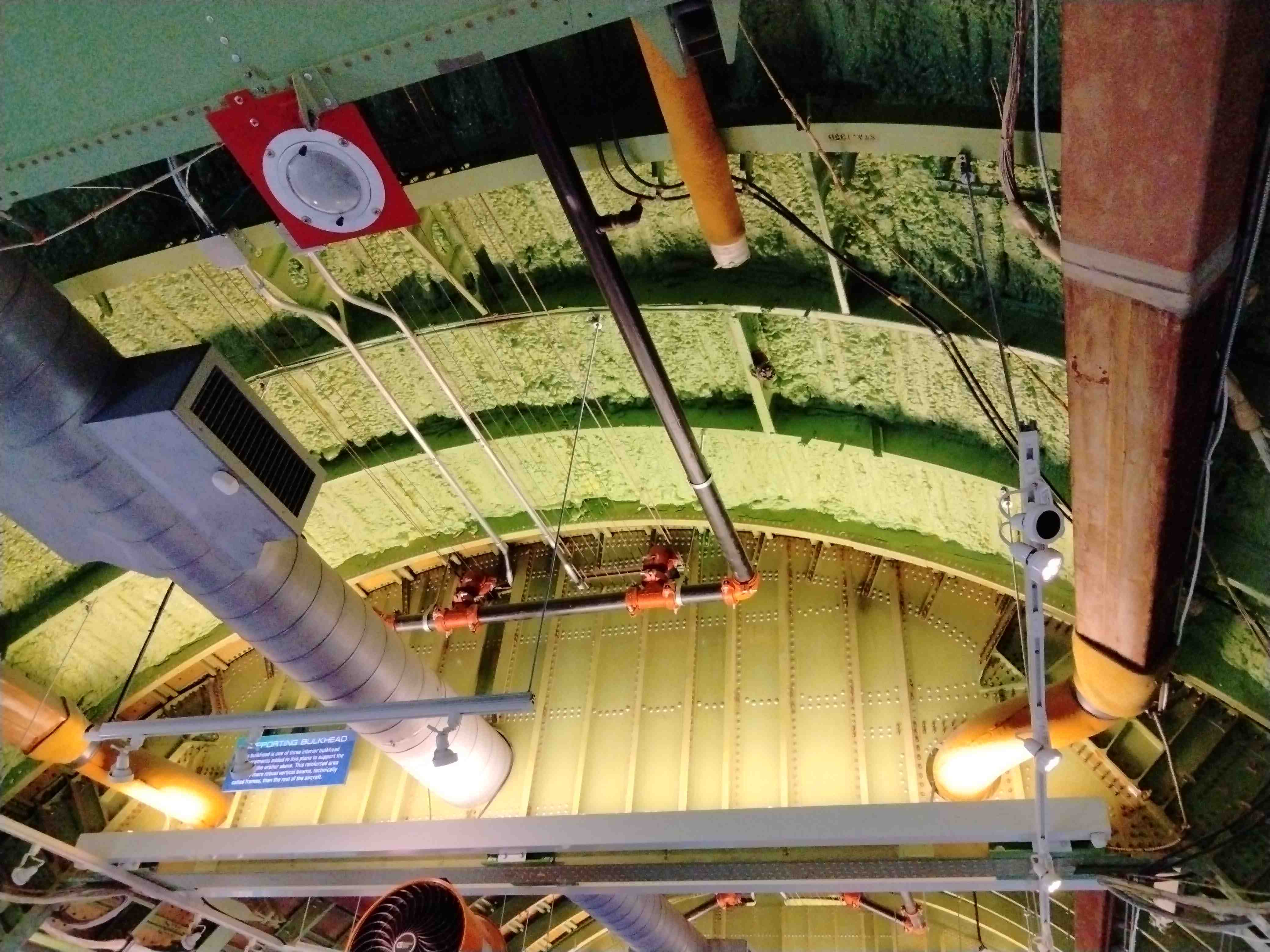Hours before NASA's Artemis 2 moon crew reveal, I saw a neat slice of space history
I even visited an old acquaintance, 40 years after they came to my Canadian hometown.

HOUSTON — On a humming museum floor, I came face-to-face with a NASA astronaut in the shadow of the moon.
I was next to an image of Jessica Watkins, who in 2022 completed the first long-duration mission by a Black woman astronaut. (She flew on SpaceX's Crew-4 flight to the International Space Station.) Watkins' face adorned the front of a new Artemis program exhibit I swooped in to visit on April 2. Overhead was a ginormous moon model, complete with craters.
I was pumped.
In less than 24 hours, I would learn the identities of the Artemis 2 moon crew during a ceremony held just minutes from here. And at Space Center Houston, I would get a taste of the nearly seven decades of space history that has led up to this exciting spaceflight moment. What better way for a space geek to spend a Sunday?
Related: Four for the moon! NASA names Artemis 2 astronaut crew for 1st lunar mission since Apollo
Space Center Houston opened in 1992 as the new visitors' hub for NASA's Johnson Space Center, the astronaut training area right next door. The museum, which says it has hosted more than 22 million visitors over its 30 years of operation, is stuffed with space history and worth a careful look if you don't have small kids to monitor. (The museum granted Space.com a free ticket, but this story was written without their oversight.)
Among the exhibits is a flown Mercury program capsule (Faith 7, from 1963), the Gemini 5 spacecraft of 1965, and Apollo 17's command module from 1972. Apollo 17 was the last crewed moon landing mission, touching down that December. Keep burrowing among the interactive exhibits, and there's plenty of lunar hardware to enjoy: a moon rock display, a lunar module test vehicle and a lunar roving vehicle trainer.
Get the Space.com Newsletter
Breaking space news, the latest updates on rocket launches, skywatching events and more!
I'm a child of the space shuttle program, however, and was delighted to see something that wasn't here during my last visit in 2008: the shuttle carrier aircraft that used to ferry the spacecraft between servicing sites on Earth. It opened to visitors in 2016. The aircraft is completely full of exhibits and explainers, but I remained distracted by the olive-green interior and original hardware.
Related: Bigger on the inside: 1st Look at Houston's new 747-space shuttle exhibit

The last time I got this close to the aircraft was as a tot in June 1983, when the prototype space shuttle Enterprise visited my hometown of Ottawa, Canada during an international goodwill tour. My parents brought me, in a stroller, like many of the visitors here at Space Center Houston. While I sadly remember nothing of that original encounter, clearly the space bug stayed with me; I wish the same for the kids I saw running around near the aircraft on April 2.
As a Canadian, I was also delighted to spot a replica Canadarm robotic arm inside the mock space shuttle atop the 747 carrier plane, called Independence. Canadarm is a huge deal in my country, as its robotic prowess assured astronaut seats on NASA missions since the dawn of the space shuttle program in 1981. In fact, our promise to build Canadarm3 is what helped secure astronaut Jeremy Hansen's seat aboard Artemis 2, which will fly around the moon no sooner than November 2024.
Related: Artemis 2's Canadian astronaut got their moon mission seat with 'potato salad'
Space Center Houston is rightly focused on space history, but when you visit such institutions, please remember that all history is connected. How we treat our community and help underprivileged, underrepresented and oppressed groups also is important (and is something that, to be fair, NASA is working to address.)
Seeing Jessica Watkins' smiling face on an exhibit is a start, as was the wide range of visitors I saw. The new Artemis push to the moon is meant to include more types of people, with NASA pledging to land the first woman and the first person of color on the moon on its Artemis 3 mission in 2025 or thereabouts. The Artemis 2 crew will include Christina Koch and Black astronaut Victor Glover, providing more equitable representation than Apollo did across all of its missions.
I can't wait to come back here again as Space Center Houston acquires artifacts associated with Artemis. And I also can't wait to see what all the little kids filling the museum that Sunday will produce as they — I very much hope — take their interests in space into engaging careers and community work.
Elizabeth Howell is the co-author of "Why Am I Taller?" (ECW Press, 2022; with Canadian astronaut Dave Williams), a book about space medicine. Follow her on Twitter @howellspace. Follow us on Twitter @Spacedotcom or Facebook.
Join our Space Forums to keep talking space on the latest missions, night sky and more! And if you have a news tip, correction or comment, let us know at: community@space.com.

Elizabeth Howell (she/her), Ph.D., was a staff writer in the spaceflight channel between 2022 and 2024 specializing in Canadian space news. She was contributing writer for Space.com for 10 years from 2012 to 2024. Elizabeth's reporting includes multiple exclusives with the White House, leading world coverage about a lost-and-found space tomato on the International Space Station, witnessing five human spaceflight launches on two continents, flying parabolic, working inside a spacesuit, and participating in a simulated Mars mission. Her latest book, "Why Am I Taller?" (ECW Press, 2022) is co-written with astronaut Dave Williams.
-
p3orion "The Artemis 2 crew will include Christina Koch and Black astronaut Victor Glover, providing more equitable representation than Apollo did across all of its missions."Reply
Quit implying racism and sexism in the early years of NASA! The early astronauts equitably "represented" ALL Americans, not just those they physically resembled. Every one of them had to meet the qualifications that had been established for Mercury, Gemini, and Apollo, among which were a minimum number of hours of piloting time in high-performance military jet aircraft. There were few African-Americans who met those minimums (whether THAT was due to MILITARY racism is an arguable point) and NO women at all!
Ed Dwight was one black Air Force officer who was hand-picked to be an astronaut, but his selection by Bobby Kennedy was rightly seen as a publicity stunt, since he had minimal flight time, and so was objectively less-qualified than anyone who had to that point been selected as an astronaut (as well as many applicants who had NOT been selected.) A better-qualified (or actually qualified) black pilot was Robert Lawrence Jr. An experienced test pilot with more than 2000 hours of jet time, he was selected as America's first black astronaut for the Air Force MOL program. When MOL was cancelled, he would no doubt have joined NASA in its Group 7 class with the other MOL astronauts, but died in the crash of an F-104.
Until the late 1970s, there were NO female military pilots with experience in high performance jets; Jerrie Cobb, the MOST experienced pilot of the so-called "Mercury 13" women, had ZERO jet time. (Yes, this disparate treatment by the U.S. military prevented women from being qualified for selection as astronauts, but it also prevented any women from being shot down in combat, which was seen as a good thing in those ignorant days.)
The current obsession with "intersectionality" leads to notice of "the first lesbian Navaho Mormon astronaut" as some kind of historic achievement, only to be forgotten in the later glare of the historic flight of "the first LEFT-HANDED lesbian Navaho Mormon astronaut." Such foolishness simply raises suspicions of whether the person was selected BECAUSE of those characteristics, rather than relevant qualifications. With a large pool of qualified applicants of all races, both men and women (and with qualifications less limiting than in those early days; see for example Chista McAuliffe) these days it can be assumed that anyone selected for a mission is qualified, but whether they are the MOST qualified among the whole astronaut corps is at least an open question.
Was there ANY doubt that there would be at least one woman and one minority astronaut selected for Artemis 2? If there was no obsession with their race and sex, it would be ASSUMED that these are the four MOST-qualified astronauts. But the concentration on stupid and irrelevant physical details ("first woman", "first black", "first Canadian", "first left-handed lesbian Navaho Mormon") calls that excellence into question, and is an insult to the hard work and excellence of ALL of them, even (or especially) those who do fit into some woke "intersectionality" pigeonhole.
Congratulations to Christina Koch, Victor Glover, Jeremy Hansen, AND Reid Wiseman. Your selection as Artemis astronauts is glory enough, and only an idiot would cheapen it by giving a damn about your race, sex, or any other IRRELEVANT characteristic.









